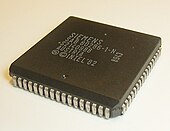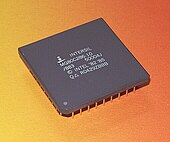Intel 80286
Intel 80386 | |
| Support status | |
|---|---|
| Unsupported |
The
The 80286 was employed for the IBM PC/AT, introduced in 1984, and then widely used in most PC/AT compatible computers until the early 1990s. In 1987, Intel shipped its five-millionth 80286 microprocessor.[8]
History and performance

Intel's first 80286 chips were specified for a maximum clockrate of 5, 6 or 8
On average, the 80286 was reportedly measured to have a speed of about 0.21
The later E-stepping level of the 80286 was free of the several significant errata that caused problems for programmers and operating-system writers in the earlier B-step and C-step CPUs (common in the AT and AT clones). This E-2 stepping part may have been available in later 1986.[11]
Intel second sourced this microprocessor to Fujitsu Limited around 1985.[12]
Variants
| Model number | Frequency | Technology | Process | Package | Date of release | Price USD[list 1] |
|---|---|---|---|---|---|---|
| 80286-10[13] | 10 MHz | HMOS-III | 1.5 μm |
July/August 1985 | $155 | |
| 80286-12[13] | 12.5 MHz | HMOS-III | 1.5 μm | July/August 1985 | $260 | |
| MG80286[14] | September/October 1985 | $784 | ||||
| 80286[15] | 68 Pin PGA[list 2] | January/February 1986 | ||||
| 80286[15] | 68 Pin PLCC[list 3] | January/February 1986 |
Architecture


Intel did not expect personal computers to use the 286.[16] The CPU was designed for
The performance increase of the 80286 over the 8086 (or 8088) could be more than 100% per
The 80286 included, in addition to all of the 8086 instructions, all of the new instructions of the 80186: ENTER, LEAVE, BOUND, INS, OUTS, PUSHA, POPA, PUSH immediate, IMUL immediate, and immediate shifts and rotates. The 80286 also added new instructions for protected mode: ARPL, CLTS, LAR, LGDT, LIDT, LLDT, LMSW, LSL, LTR, SGDT, SIDT, SLDT, SMSW, STR, VERR, and VERW. Some of the instructions for protected mode can (or must) be used in real mode to set up and switch to protected mode, and a few (such as SMSW and LMSW) are useful for real mode itself.
The Intel 80286 had a 24-bit address bus and as such had a 16 MB physical address space, compared to the 1 MB address space of prior x86 processors. It was the first x86 processor to support virtual memory supporting up to 1 GB via segmentation.[19] However, memory cost and the initial rarity of software using the memory above 1 MB meant that until late in its production, 80286 computers rarely shipped with more than 1 MB of RAM.[18] Additionally, there was a performance penalty involved in accessing extended memory from real mode as noted below.
Features



Protected mode
The 286 was the first of the x86 CPU family to support protected virtual-address mode, commonly called "
Several additional instructions were introduced in the protected mode of 80286, which are helpful for multitasking operating systems.
Another important feature of 80286 is the prevention of unauthorized access. This is achieved by:
- Forming different segments for data, code, and stack, and preventing their overlapping.
- Assigning privilege levels to each segment. Segments with lower privilege levels cannot access segments with higher privilege levels.
In 80286 (and in its co-processor
- unsigned packed decimal,
- unsigned binary,
- unsigned unpacked decimal,
- signed binary,
- 80287).
By design, the 286 could not revert from protected mode to the basic 8086-compatible real address mode ("
In theory, real-mode applications could be
To support protected mode, new instructions have been added: ARPL, VERR, VERW, LAR, LSL, SMSW, SGDT, SIDT, SLDT, STR, LMSW, LGDT, LIDT, LLDT, LTR, CLTS. There are also new exceptions (internal interrupts): invalid opcode, coprocessor not available, double fault, coprocessor segment overrun, stack fault, segment overrun/general protection fault, and others only for protected mode.
OS support
The protected mode of the 80286 was not routinely utilized in PC applications until many years after its release, in part because of the high cost of adding extended memory to a PC, but also because of the need for software to support the large user base of 8086 PCs. For example, in 1986 the only program that made use of it was VDISK, a
In January 1985,
The problems led to Bill Gates famously referring to the 80286 as a "brain-dead chip",[25][failed verification][when?] since it was clear that the new Microsoft Windows environment would not be able to run multiple MS-DOS applications with the 286. It was arguably responsible for the split between Microsoft and IBM, since IBM insisted that OS/2, originally a joint venture between IBM and Microsoft, would run on a 286 (and in text mode).
Other operating systems that used the protected mode of the 286 were Microsoft
Support components
This list of bus interface components that connects to Intel 80286 microprocessor.
- 82230/82231 High Integration AT-Compatible Chip Set - The 82230 covers this combination of chips: 82C284 clock, 82288 bus controller, and dual 8259A interrupt controllers among with other components. The 82231 covers this combination of chips: 8254 interrupt timer, 74LS612 memory mapper and dual 8237A DMA controller among with other components. They are available by second-sourced with Zymos Corp. Both set are available USD $60 for 10 MHz version and USD $90 for 12 MHz version in quantities of 100.[30]
- 82258 Advanced Direct Memory Access Controller – Transfer rate of 8MB per second, supports up to 32 subchannels, mask and compare, verify, translation, and assembly/disassembly operation that are being processed simultaneously. It also support 16MB addressing range. These were available for USD $170 in quantities of 100.[31]
- 82C284 Clock Generator and Driver - Intel second sourced this 82284 version to Fujitsu Limited around 1985.[32] The Intel branded chipset was available in 20-pin PLCC in sampling at first quarter 1986.[15]
- 82288 Bus Controller
- 82289 Arbiter
See also
- iAPX, for the iAPX name
- LOADALL – Undocumented 80286/80386 instruction that could be used to gain access to all available memory in real mode.
- Windows/286
References
- ^ "CPU History - The CPU Museum - Life Cycle of the CPU". cpushack.com. Archived from the original on July 20, 2021. Retrieved September 6, 2021.
- ^ "1.5 µm lithography process - WikiChip". en.wikichip.org. Archived from the original on September 9, 2018. Retrieved January 21, 2019.
- ^ Ormsby, John, "Chip Design: A Race Worth Winning", Intel Corporation, Microcomputer Solutions, July/August 1988, page 18
- ^ "Microprocessor Hall of Fame". Intel. Archived from the original on July 6, 2007. Retrieved August 11, 2007.
- ^ iAPX 286 Programmer's Reference (PDF). Intel. 1983. page 1-1. Archived (PDF) from the original on August 28, 2017. Retrieved August 28, 2017.
- ^ A simpler cousin in the 8086-line with integrated peripherals, intended for embedded systems.
- ^ "Intel Museum – Microprocessor Hall of Fame". Intel.com. May 14, 2009. Archived from the original on March 12, 2009. Retrieved June 20, 2009.
- ^ Teixeira, Kevin, "What's Next For The 80286?", Intel Corporation, Microcomputer Solutions, November/December 1987, page 16
- ^ "Intel Architecure [sic] Programming and Information". Intel80386.com. January 13, 2004. Retrieved April 28, 2009.
- ^ "80286 Microprocessor Package, 1982". Content.cdlib.org. Archived from the original on March 6, 2019. Retrieved April 28, 2009.
- ^ from the original on January 25, 2014. Retrieved December 25, 2021.
- ^ Intel Corporation, "NewsBits: Second Source News", Solutions, January/February 1985, Page 1.
- ^ a b Intel Corporation, "New Product Focus Components: 80286 Workhorses: Twice As Fast", Solutions, July/August 1985, Page 17.
- ^ Intel Corporation, "New Product Focus Components: Highest Ranking 16-bit Microprocessor Meets Military Objectives", Solutions, September/October 1985, page 13.
- ^ a b c Ashborn, Jim; "Advanced Packaging: A Little Goes A Long Way", Intel Corporation, Solutions, January/February 1986, Page 2
- ^ Gross, Neil; Coy, Peter (March 6, 1995). "The Technology Paradox". Bloomberg. Retrieved March 19, 2020.
- ^ "Intel 80286 microprocessor family". CPU-World. Archived from the original on March 31, 2012. Retrieved May 19, 2012.
- ^ ISBN 978-8120339422. Archivedfrom the original on February 27, 2017. Retrieved October 11, 2016.
- ^ Intel Corporation, "New Product Focus Components: Highest Ranking 16-bit Microprocessor Meets Military Objectives", Solutions, September/October 1985, page 13
- ^ Petzold, Charles (1986). "Obstacles to a grown up operating system". PC Magazine. 5 (11): 170–74. Archived from the original on February 27, 2017. Retrieved October 11, 2016.
- ^ from the original on February 27, 2017. Retrieved October 11, 2016.
- Digital Research, Inc. November 1986. Archived(PDF) from the original on April 21, 2019. Retrieved August 14, 2018.
- Concurrent DOS 286, including STRUCT.H explicitly mentioning LOADALLfor "8086 emulation".)
- ^ Calvo, Melissa; Forbes, Jim (February 10, 1986). "IBM to use a DRI operating system". InfoWorld. Vol. 8, no. 8. p. 12. Archived from the original on April 21, 2019. Retrieved September 6, 2011.
- ISBN 0-07-016638-2.
- ^ "Microsoft XENIX 3.0 Ready for 286" (PDF). Archived from the original (PDF) on January 7, 2014.
- ^ "An Introduction to Coherent: General Information FAQ for the Coherent Operating System". Archived from the original on June 4, 2016. Retrieved January 7, 2014.
- ^ "MINIX INFORMATION SHEET". Archived from the original on January 7, 2014.
- PC Magazine. pp. 150–152.
- ^ Ormsby, John, Editor, "New Product Focus: Components: Intel's 82X3X Chip-set Handles Logic Functions That Once Required The Services Of Sources Of Chips", Intel Corporation, Microcomputer Solutions, January/February 1988, page 13
- ^ Intel Corporation, "New Product Focus Components: The 82258 ADMA Boost iAPX 286 Family Performance", Solutions, November/December 1984, Page 14.
- ^ Intel Corporation, "NewsBits: Second Source News", Solutions, January/February 1985, Page 1
- ^ "Soviet microprocessors, microcontrollers, FPU chips and their western analogs". CPU-world. Archived from the original on February 9, 2017. Retrieved March 24, 2016.
External links
- Intel Datasheets
- Intel 80286 and 80287 Programmer's Reference Manual at bitsavers.org
- Intel 80286 Programmer's Reference Manual 1987 (txt). Hint: use e.g. Hebrew (IBM-862) encoding.
- Linux on 286 laptops and notebooks
- Intel 80286 images and descriptions at cpu-collection.de
- CPU-INFO: 80286, in-depth processor history
- Overview of all 286 compatible chips
- Intel 80286 CPU Information, including chip errata and undocumented behaviour
- Intel 80286 Hardware Reference Manual
